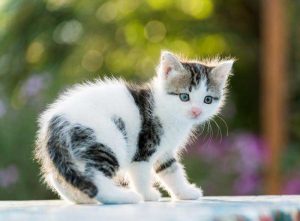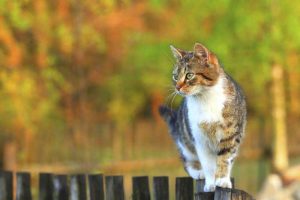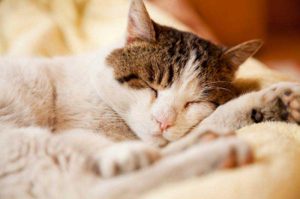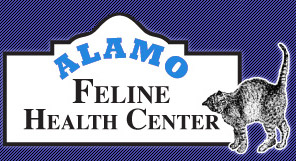 Kittens
Kittens
New kittens are a delight for young and old alike. They are innocent and trusting, but they also show the classic independence that defines the feline species.
There are some important things you need to know about your new kitten. Most of that material will be discussed with you when you bring your kitten for its first visit. However, there are some things you need to know before that first visit.
Introducing a New Kitten to its New Environment
A cat is naturally inclined to investigate its new surroundings. It is suggested that the cat’s area of exploration be limited initially so that these natural tendencies do not create an unmanageable task. After confining the cat to one room for the first few days, you should slowly allow access to other areas of the home.
Introducing a New Kitten to Other Cats in the Household
Most kittens receive a hostile reception from other household pets, especially from another cat. The other cat usually sees no need for a kitten in the household, and these feelings are reinforced if it perceives that favoritism is being shown to the kitten. The existing cat must not feel that it is necessary to compete for food or for attention. The new kitten should have its own food and food bowl, and it should not be permitted to eat from the other cat’s bowl. Although it is natural to spend time holding and cuddling the kitten, the existing cat may think that it is being neglected. The new kitten needs lots of love and attention, but the transition will be smoother if the existing cat is given more attention than normal.
The introduction period will usually last one to two weeks and will have one of three possible outcomes:
- The existing cat will remain hostile to the kitten. Fighting may occur occasionally, especially if both try to eat out of the same bowl at the same time. This is an unlikely occurrence if competition for food and affection are minimized during the first few weeks.
- The existing cat will only tolerate the kitten. Hostility will cease, but the existing cat will act as if the kitten is not present. This is more likely if the existing cat is very independent, has been an only cat for several years, or if marked competition occurred during the first few weeks. This relationship is likely to be permanent.
- Bonding will occur between the existing cat and the kitten. They will play together, groom each other, and sleep near each other. This is more likely to occur if competition is minimized and if the existing cat has been lonely for companionship.
Playing Behavior in Kittens
Stimulating play is important during the first week. Stalking and pouncing are important play behaviors in kittens and have an important role in proper muscular development. If given a sufficient outlet for these behaviors with toys, your kitten will be less likely to use family members or furniture for these activities. The best toys are light weight and movable. These include wads of paper, small balls, and string or ribbon. Kittens should always be supervised when playing with string or ribbons to avoid swallowing them. Any other toy that is small enough to be swallowed should also be avoided.
Vaccinations
There are many diseases that are fatal to cats. Fortunately, we have the ability to prevent many of these by using very effective vaccines. In order to be effective, these vaccines must be given as a series of injections. Ideally, they are given at about 6-8, 12, and 16 weeks of age, but this schedule may vary somewhat depending on several factors. Note that we need to see your cat when it is 6-8 weeks of age for the first visit.
The routine vaccination schedule will protect your kitten from four diseases: distemper, two respiratory viruses, and rabies. The first three are included in a combination vaccine that is given at 6-8, 12, and 16 weeks old. Rabies vaccine is given at 16 weeks of age. Leukemia vaccine and the feline aids vaccine are necessary if your cat does or will go outside or if you have another cat that goes in and out since these deadly diseases are transmitted by contact with other cats, especially when fighting occurs. When you come in for an appointment, the veterinarian will discuss with you which vaccines are appropriate for your cat.
Feeding a Kitten
Diet is extremely important in the growing months of a cat’s life, and there are two important criteria that should be met in selecting food for your kitten. We recommend a NAME-BRAND FOOD made by a national cat food company (not a generic or local brand), and a form of food MADE FOR KITTENS. This should be fed until your kitten is about 12 months of age. We recommend that you only buy food that has the AAFCO certification. Usually, you can find this information very easily on the label. AAFCO is an organization that oversees the entire pet food industry. It does not endorse any particular food, but it will certify that the food has met the minimum requirements for nutrition. Most of the commercial pet foods will have the AAFCO label. Generic brands often do not have it.
Feeding a dry, canned, or semi-moist form of cat food is acceptable. Each has advantages and disadvantages. Dry food is definitely the least expensive. It can be left in the cat’s bowl at all times. If given the choice, the average cat will eat a mouthful of food about 12-20 times per day. The good brands of dry food are just as nutritious as the other forms. As a rule, most veterinarians will recommend dry food for your kitten.
Semi-moist and canned foods are also acceptable. However, both are considerably more expensive than dry food. They often are more appealing to the cat’s taste; however, they are not more nutritious. If you feed a very tasty food, you are running the risk of creating a cat with a finicky appetite. In addition, the semi-moist foods are high in sugar.
Table foods are not recommended. Because they are generally very tasty, cats will often begin to hold out for these foods and not eat their well-balanced cat food. If you choose to give your kitten table food, be sure that at least 90% of its diet is high quality commercial kitten food.
We enjoy a variety of things to eat in our diet. However, most cats actually prefer not to change from one food to another unless they are trained to do so by the way you feed them. Do not feel guilty if your cat is happy to just eat one food day after day, week after week.
Commercials for cat food can be very misleading. If you watch carefully you will notice that many commercials promote cat food on one basis, TASTE. Nutrition is rarely mentioned. Most of the “gourmet” foods are marketed to appeal to owners who want the best for their cats; however, they do not offer the cat any nutritional advantage over a good quality dry food, and they are far more expensive. If your cat eats a “gourmet” food very long, it will probably not be happy with other foods. If it needs a special diet due to a health problem later in life, it will be very unlikely to accept it. Therefore, we do not encourage feeding “gourmet” cat foods.
Flea Control
Fleas do not stay on your kitten all of their time. Occasionally, they will jump off and seek another host. Therefore, it is important to kill fleas on your new kitten before they can become established in your house. Many of the flea control products that are safe on adult cats are not safe for kittens less than 4 months of age. Be sure that any flea product you use is labeled as safe for kittens.
If you use a flea spray, your kitten should be sprayed lightly. Flea and tick dip is not recommended for kittens unless they are at least 4 months of age. Remember, not all insecticides that can be used on dogs are safe for cats and kittens.
There is a trick to spraying a kitten that will make the outcome safer and more successful. When a kitten is sprayed, the fleas tend to run away from the insecticide. If you spray the body first, many fleas will run to the head where they are very difficult to kill. The best method is to spray a cotton ball then use that to wipe the flea spray onto the kitten’s face, from the nose to the level of the ears. That will keep you from getting it in the eyes and will cause the fleas to run down the neck toward the body. Wait about 2 minutes, then spray the body. Leave the spray on for about 3 minutes, then wipe off the excess. This will permit you to kill the most fleas while putting the least amount of insecticide on the kitten.
There are four products that are given only once per month. Program® is a tablet that causes the adult fleas to lay sterile eggs. It is very effective, but it does not kill adult fleas that usually live 2-3 months. Advantage® and Frontline Top Spot® are the monthly products that kill adult fleas. They are liquids that are applied to the skin at the base of the neck. They are very effective and easy to use. Revolution® is the newest product. In addition to killing fleas, it will also prevent your cat from getting heartworms, ear mites, the most common intestinal worms, and ticks. It is a topical that is applied once each month.
 The Annual Visit
The Annual Visit
Most cat owners believe that they take their cats to their veterinarian each year “for shots.” Most feline vaccines are given annually for maximum efficacy. However, the veterinary profession has done its patients a disservice through the years by placing emphasis on the vaccines as the main reason for the annual visit. Rabies drives and mobile vaccine services have also reinforced this notion.
Cats age much faster than humans do. Roughly, it is about a 5 to 1 ratio. (See the “Senior Cats” page for a more specific comparison.) For each calendar year that passes, your cat undergoes a significant amount of changing and aging. During one calendar year, many diseases can begin and advance to a serious stage. This brings us to the “real reason” for the annual visit.
When you bring your cat to Alamo Feline Health Center for its annual visit, please be prepared for more than a quick in-and-out trip. Please allow enough time in your schedule for us to do the following:
We begin with an extensive history form. This allows you to tell us what has happened to your cat during the last few months and during its lifetime in regard to health issues. It brings out important issues that need to be discussed.
Our technicians perform an EKG (electrocardiogram) to assess several important aspects of heart function. You will be impressed with our high-tech EKG machine that is simply pressed on your cat’s chest wall.
One of our doctors will perform a very thorough physical examination. We start at the nose and work our way to the tail. Our goal is to find disease in its early stage. Several aspects of the examination are tailored to the special needs of cats. Abnormalities that are detected are noted for further discussion. For some cats, blood is taken to perform tests for specific diseases. These tests are also chosen based on lifestyle, age, and risk factors. Needed vaccinations are given, either by the doctor or by one of our highly trained technicians. They are individually chosen based on disease risk factors.
A list of specific recommendations for general health care of cats is given to you. This catalogs the latest recommendations on caring for your cat. It also includes a list called “Early Signs of Disease.” This is important information that equips you to detect many diseases in their early, and usually treatable, stages.
 Seniors (10yrs +)
Seniors (10yrs +)
Aging is a natural process that we all experience. However, it brings with it some changes that are not particularly desirable. Forestalling and controlling certain aspects of the aging process are possible if the appropriate measures are taken in a timely manner. The purpose of this page is to inform you of appropriate measures that should be taken for older cats.
At what age is a cat a senior citizen?
That is a fair question because cats age at a different rate than we do. During the first year of life, a cat achieves adulthood. Therefore, that first year is equivalent to about 18 human years. After that, the cat ages in a fairly linear fashion. Each year then becomes the equivalent to about 5 human years. Based on that scheme, a comparison of feline and human years is as follows:
| Feline Age | Human Age |
|---|---|
| 1 years | 16 years |
| 3 years | 25 years |
| 5 years | 33 years |
| 7 years | 41 years |
| 9 years | 49 years |
| 11 years | 57 years |
| 12 years | 61 years |
| 13 years | 65 years |
| 14 years | 69 years |
| 15 years | 73 years |
| 16 years | 77 years |
| 18 years | 85 years |
| 20 years | 94 years |
Based on this aging scheme, any cat over 10 years of age is what we call a “senior cat.”
Common Ailments of Senior Cats
Many senior cats get a bit lazy in their grooming habits. They often begin to develop mats in their hair coat. Therefore, frequent (1-3 times per week) brushing is important. Brushing collects the dead hair that they would remove by grooming, and it removes tangles before they become mats. However, occasionally it will be necessary to cut out a mat. Be very careful with scissors or clippers because many elderly cats have very thin skin that cuts or tears easily.
Senior cats also lose the desire or ability to sharpen their nails regularly. The nails become very thick because the dead nail tissue is retained. Failure to sharpen nails can also result in the nail curling backward into the pad. This will be most uncomfortable and will result in lameness and bleeding. The key to preventing these problems is to cut your cat’s nails at least once each month.
Dental disease is common in older cats. The two most common forms of dental disease are tartar buildup with resulting periodontal disease and deep cavities near the gum line. Tartar buildup is common in cats of any age, but older cats often have heavy tartar buildup due to years of dental neglect. The tartar irritates the gums, pushes the gums away from the roots of the teeth, and harbors bacteria. The bacteria not only affect the mouth but they are also carried by the blood stream to other organs, notably the kidneys. Tartar buildup and periodontal disease are very treatable with proper cleaning and antibiotic therapy. The cavities that form are called Cervical Line Lesions (CLL’s). They form at the gum line and are often covered by the gums that proliferate over them. The cat is very painful when that tooth is touched; it may have difficulty eating. The only realistic treatment is extraction of the tooth. Attempts have been made to fill these cavities, but invariably these teeth undergo further deterioration and need to be extracted a few weeks to months later.
Eyesight is usually not lost in older cat although it can become diminished, especially in dim lighting situations. However, the irises (the colored part of the eye that opens and closes) often begin to get a mottled appearance about 15 years of age.
The ears often are afflicted with two problems. Hearing loss and outright deafness occur in many cats over 16 years of age. It is permanent. Excessive wax production is more common. Many older cats have very waxy ears that need cleaning about once each month. We prescribe a wax solvent that is put in the ears the first 5 days of each month or possibly every other month.
Arthritis occurs in the spine or legs of some geriatric cats. It results in them being reluctant or unable to jump on and off furniture or hesitant to climb stairs. We are limited in the drugs that can be used safely in arthritic cats, so a close examination and discussion of options is important.
Common Diseases of Senior Cats
Senior cats also develop certain major diseases with increasing frequency. The most common of these are diabetes, chronic kidney failure, hyperthyroidism, high blood pressure, and cancer. Each will be described briefly.
Diabetes (more correctly called diabetes mellitus) is a failure of adequate insulin production. Insulin is required to move blood sugar (glucose) from the blood into the cells. It results in excess urine production, increased thirst, weight loss, and a ravenous appetite. Although these signs should be present in all diabetic cats, some of them may be missed. This is especially a problem when cats go outside because they may eat, drink, and urinate outdoors. If you have several cats and they all eat and drink together, an increased thirst or urine production will easily be missed. Longhaired cats can lose a substantial amount of weight without detection, so weight loss can also be missed. If you suspect that any of these signs are occurring, your cat needs a blood test for its blood glucose level. It is most accurate if your cat has not eaten for at least 6 hours. Diabetes Mellitus is very treatable.
Chronic kidney failure is the result of many years of slow deterioration of the kidneys. Kidney infections, certain toxins, and congenital diseases may be part of this deterioration process, but aging is the major factor. Something has to wear out first, and in many cats it is the kidneys. Cats in kidney failure are actually producing an excess amount of urine in an attempt to remove waste products that are accumulating in the blood. This results in increased thirst. Gradual weight loss is also common, and loss of appetite occurs as the disease progresses. It can be diagnosed with some simple blood and urine tests. It is treatable if treatment begins before the kidney failure is advanced.
Hyperthyroidism is due to an enlargement of the thyroid gland. This gland controls the body’s rate of metabolism so metabolism is accelerated. The first sign is weight loss followed by an increase in appetite as the cat tries to “catch up.” As the disease progresses (over several weeks to months), increased thirst and urination, vomiting, diarrhea, hyperactivity, and lack of sleep may also occur. It is diagnosed by feeling for thyroid gland enlargement and some simple blood tests. The good news is that 98% of the time, the enlargement is a benign condition; therefore, this is a very treatable, and even curable, disease.
High blood pressure, more accurately called hypertension, is fairly common in senior cats. Most of the time it is secondary to either chronic kidney failure or hyperthyroidism. However, it appears that a few cats may have “essential” or “primary” hypertension. This means that there is not an underlying disease, as occurs in many humans. This disease is suspected in cats with the two underlying diseases; it is diagnosed by measuring your cat’s blood pressure. Because your cat’s arteries are so small, a special instrument is required. The most common one used is based on the Doppler principle. Hypertension is very treatable.
Cancer is another common disease in senior cats. There are so many forms of cancer that it is impossible to list specific clinical signs. The signs will be determined by the parts of the body that are affected. Therefore, weight loss, anemia, lethargy, loss of appetite, vomiting, diarrhea, difficulty breathing, and coughing are all possible. However, it is unlikely that all of those would occur in any one cat.
Early Detection
Early detection is the key to successful treatment of all of these diseases. Most of them can be controlled or cured if diagnosed early enough. We recommend a panel of tests for our senior patients. These tests begin with a thorough history of your cat’s past and present health. Next is a good physical examination. Then we perform a blood and urine panel that includes specific tests for diabetes, chronic kidney failure, and hyperthyroidism. Blood pressure is determined. If any of these tests have questionable results, other tests are added including chest x-rays (radiographs), ultrasound studies, and possible biopsies of suspected abnormal organs. If you wish for your cat to have this Geriatric Panel of tests, please schedule it with one of our receptionists.
